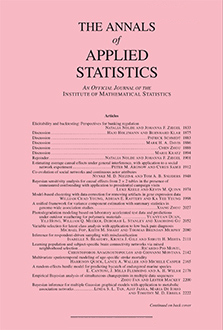Abstract
Testing of the disjunction hypothesis is appropriate when each gene or location studied is associated with multiple $p$-values, each of which is of individual interest. This can occur when more than one aspect of an underlying process is measured. For example, cancer researchers may hope to detect genes that are both differentially expressed on a transcriptomic level and show evidence of copy number aberration. Currently used methods of $p$-value combination for this setting are overly conservative, resulting in very low power for detection. In this work, we introduce a method to test the disjunction hypothesis by using cumulative areas from the Voronoi diagram of two-dimensional vectors of $p$-values. Our method offers much improved power over existing methods, even in challenging situations, while maintaining appropriate error control. We apply the approach to data from two published studies: the first aims to detect periodic genes of the organism Schizosaccharomyces pombe, and the second aims to identify genes associated with prostate cancer.
Citation
Daisy Phillips. Debashis Ghosh. "Testing the disjunction hypothesis using Voronoi diagrams with applications to genetics." Ann. Appl. Stat. 8 (2) 801 - 823, June 2014. https://doi.org/10.1214/13-AOAS707
Information





